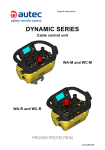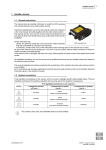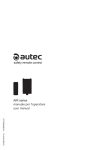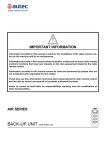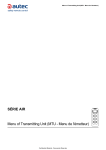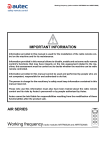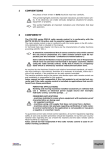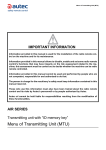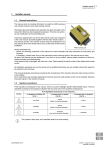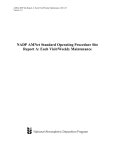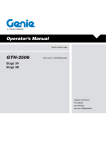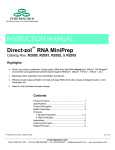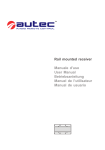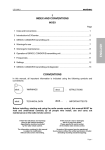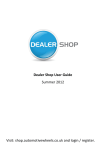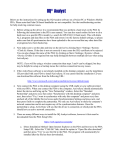Download compliance - IndustryIQ
Transcript
Dynamic series user manual Description, warnings and instructions Conformity and frequencies (915 MHz) Original instructions The attached documentation is an integral part of the radio remote control and it aims at providing the instructions needed for using and maintaining the system, with an eye on its safety functions. Always remember that: - photos and drawings are useful examples that help understand the instructions and warnings of each radio remote control configuration - if necessary, contact Autec if any of the instructions and/or warnings are not clear No part of the documentation may be reproduced, in any form or by any means, without written permission of Autec (including recording and photocopying). If documentation is lost or damaged, ask Autec for a copy. Please specify the serial number of the related radio remote control. The documentation must be kept for the whole life of the radio remote control: after reading it, keep it on hand for future reference. Information contained in the documentation adds to and completes the information provided by the manufacturer of the remote controlled and/or by those who install the radio remote control on the machine. All installation, usage and maintenance operations must be carried out by qualified technicians who are suitably trained with respect to the relevant norms and laws. Therefore, this documentation must be read and understood in all its parts by the user and by: - the radio remote control owner and/or installer - the person responsible for and in charge of maintenance and/or safety in the workplace where the radio remote control is used. As for instructions and warnings regarding the machine where the radio remote control is installed, follow the instructions given in the machine's manual. Three symbols are employed throughout documentation, which are used to highlight specific safety-related issues. They are classified according to the hazardous situation that may arise and on the possible consequences: If the highlighted instructions are not respected this… Symbol ... leads to a dangerous situation … ... may lead to consequences for people … ... may lead to consequences for property … …highly probable. … critical (death or physical damage). … critical. … probable. … critical (death or physical damage). … critical. … probable. … moderate (nonsevere physical damage). … moderate. This symbol is also used, and it identifies texts to be read carefully. INDEX Part A: Description, warnings and instructions 1 Dynamic Series description ............................................................................... A - 1 1.1 Technical data ................................................................................................. A - 1 1.2 Applications ..................................................................................................... A - 2 1.3 Radio link ........................................................................................................ A - 2 1.4 Classification of commands ............................................................................ A - 2 1.5 Safety functions .............................................................................................. A - 3 1.6 Identifying the radio remote control ................................................................. A - 4 2 Risk assessment ................................................................................................. A - 5 2.1 Risk assessment for radio remote controlled machines ................................. A - 5 2.2 Working conditions .......................................................................................... A - 6 3 Warnings .............................................................................................................. A - 7 3.1 Before starting to work .................................................................................... A - 7 3.2 During normal operation ................................................................................. A - 7 3.3 After using the radio remote control ................................................................ A - 8 4 Radio remote control lifecycle ........................................................................... A - 9 4.1 Transportation and storage ............................................................................. A - 9 4.2 Installation ....................................................................................................... A - 9 4.3 Use .................................................................................................................. A - 9 4.4 Radio remote control maintenance ............................................................... A - 10 4.5 Machine maintenance ................................................................................... A - 14 4.6 Disposal ........................................................................................................ A - 14 5 General operating instructions ........................................................................ A - 15 5.1 Starting up the radio remote control .............................................................. A - 15 5.2 Command activation ..................................................................................... A - 15 5.3 Data Feedback Function ............................................................................... A - 15 5.4 Radio link interruption ................................................................................... A - 16 5.5 Transmitting unit automatic switch off ........................................................... A - 16 5.6 Switching off the transmitting unit ................................................................. A - 17 5.7 Switching off the receiving unit ..................................................................... A - 17 6 Working .............................................................................................................. A - 18 6.1 BATTERY ..................................................................................................... A - 18 6.2 S-KEY ........................................................................................................... A - 18 6.3 START pushbutton ....................................................................................... A - 19 6.4 STOP ............................................................................................................ A - 19 6.5 Command meaning ....................................................................................... A - 19 6.6 Low Power function ....................................................................................... A - 21 6.7 Cable control ................................................................................................. A - 21 7 Troubleshooting ................................................................................................ A - 23 7.1 Radio remote controls with Data Feedback function .................................... A - 23 7.2 Radio remote controls with wire control ........................................................ A - 23 AUTEC ENG 7.3 Solutions in case of malfunction ................................................................... A - 23 Part B: Conformity and frequencies 1 Conformity ........................................................................................................... B - 1 2 Frequencies ......................................................................................................... B - 1 2.1 Dynamic mode ................................................................................................ B - 2 2.2 Static mode ..................................................................................................... B - 2 3 Market ................................................................................................................... B - 2 Original instructions Dynamic Series description A-1 DYNAMIC SERIES Part A: Description, warnings and instructions 1 Dynamic Series description Autec Dynamic series industrial radio remote controls are used to control machines from a distance, without physical connections (i.e. wires or connecting cables) between the user and the machine. Each of these industrial radio remote controls consists of a portable transmitting unit, from which the user can remotely control the machine, and a receiving unit installed on board the machine itself. 1.1 Technical data Command response time ................................................................................. 80 - 130 ms Active stop cut-in time (typical) ............................................................................. < 130 ms Active stop cut-in time (maximum)........................................................................... 200 ms Passive stop cut-in time1 ............................................................................... 0.5 / 1.2 / 2 s Hamming distance ........................................................................................................ ≥ 15 Probability of undetected error.................................................................................. < 10-15 Typical working range ................................................................................... 100 m (330 ft) Working range with Low Power function.......................................................... 30 m (100 ft) Performance Level of safety functions according to EN ISO 13849-1 / EN IEC 62061: STOP protection ....................................................................... PL e / SIL 3 (4-wire wiring) STOP protection ....................................................................... PL d / SIL 2 (2-wire wiring) Protection against unintended movements from the standstill position (UMFS) ................. ........................................................................................................................... PL d / SIL 2 1. Passive stop cut-in time is set by the machine manufacturer (see technical data sheet) AUTEC LIDYNE00-02.fm Dynamic Series Part A: Description, warnings and instructions ENG A-2 Dynamic Series description 1.2 Applications In compliance with the risk assessment (see chapter 2), this radio remote control can be installed on hoisting and material handling machines and on machines for moving, raising and transporting people (i.e. hydraulic cranes, aerial work platforms, telehandlers, concrete pumps). This radio remote control cannot be installed: - on machines installed in places where equipment with explosion-proof characteristics is required - on machines where the receiving unit power supply does not come from a battery or from a power supply unit with safety isolating transformer - to control loads that are not isolated from AC power supply (if that is the case) - on machines that may generate dangerous situations if they stop due to the loss of radio link - on machines for which a risk assessment (see chapter 2) is not possible or gave negative results. Autec cannot be held responsible if the radio remote control is installed on forbidden applications. 1.3 Radio link The two units constantly communicate with one another through a radio link. This is an essential requirement to ensure safety for the radio remote controlled machine. Messages from the units are coded through an address stored in the S-KEY (see paragraph 6.2). This address is unique (Autec produces it only once), univocal (specific for each radio remote control) and not reproducible. Each unit can only decode the messages coming from the unit with the same address. This prevents messages from other radio equipment from activating any system function. The units send coded messages to one another: - messages sent by the transmitting unit contain operational commands to be carried out by the machine - messages sent by the receiving unit contain information useful for the automatic management of the working frequency and information about measurements collected from the machine (Data Feedback function). 1.4 Classification of commands Commands sent by the transmitting unit are classified according to their type. Dynamic Series Part A: Description, warnings and instructions Dynamic Series description A-3 1.4.1 Command type: analogue, digital or direction command Commands sent by the transmitting unit can either be analogue or digital. Analogue commands generate proportional outputs as a function of the position of the corresponding actuator. Digital commands switch the status of their corresponding output, according to the position of the related actuator. This status can either be on or off. Direction commands are digital commands paired with analogue commands, and are used to specify the movement direction. 1.4.2 Name of commands All commands sent by the transmitting unit are identified by abbreviations, which are also written in the technical data sheet to highlight the match between commands sent and machine functions. The names of outputs in the receiving unit are not the names of commands. Check the technical data sheet to know which name they were given. 1.5 Safety functions Autec radio remote controls are equipped with some functions that provide high safety levels, in order to safeguard the safety of people and property. 1.5.1 Stop function The stop function brings the machine to a safe state every time it is necessary to stop it due to a potentially hazardous situation. This function is either voluntarily enabled by the user (active stop), as appropriate, or it cuts in automatically and autonomously (passive stop). Active stop Active stop is a function enabled by the STOP pushbutton (see paragraph 6.4). The transmitting unit sends to the receiving unit a command that immediately stops the machine. When the STOP pushbutton is pressed, the machine stops in shorter time than when passive stop cuts in. Passive stop Passive stop is a function that cuts in when a fault occurs during operation. When the radio link is incorrect or interrupted, the receiving unit autonomously stops the radio remote control. The cut-in time of this function (passive stop cut-in time) is set by the machine manufacturer (see technical data sheet). 1.5.2 Protection against unintended movements from the standstill position (UMFS) This safety function protects the system “machine+radio remote control” from unintended movements, namely machine movements not activated intentionally by AUTEC LIDYNE00-02.fm Dynamic Series Part A: Description, warnings and instructions ENG A-4 Dynamic Series description the user, but resulting from possible electrical and mechanical failure of the radio remote control. Such safety function checks the neutral (rest) position of the actuators that control the machine's movements. Each time one of those actuators is operated, the transmitting unit sends both the movement command and the “SAFETY” command. Depending on the specific application, outputs related to these commands are wired in series; alternatively the SAFETY command's outputs drive the safety device provided on the machine. 1.6 Identifying the radio remote control The serial number (S/N) is the only reference to be used to uniquely identify the radio remote control, both if maintenance is needed and when providing statements to competent bodies. The serial number (S/N) and other information regarding the radio remote control are provided in some plates both on the transmitting and on the receiving unit. These plates must not be: - removed from their position (removal will invalidate the guarantee) - altered or damaged (contact Autec for replacement). Dynamic Series Part A: Description, warnings and instructions Risk assessment A-5 2 Risk assessment As required standards ISO 12100 and ISO 14121, all machines must undergo risk assessment. It is therefore necessary to evaluate, within the limits of this assessment, if the machine can be radio remote controlled. The radio remote control can only be used if this assessment gives positive results. 2.1 Risk assessment for radio remote controlled machines All warnings listed in this manual must also be taken into account during risk assessment and when setting out protection measures for the controlled machine. When carrying out risk assessment for the machine or for the system where the radio remote control is installed, the following must be considered: - some machines cannot be radio remote controlled by Dynamic series radio remote controls (see paragraph 1.1) - the radio link between the two units may be interrupted due to persistent disturbance or interference. Whenever the radio link is interrupted (i.e. due to active stop, passive stop, low battery, automatic switch off, receiving unit not powered): - all outputs in the receiving unit are disabled (if this generates a hazardous situation, it is necessary that the corresponding commands on the machine are kept active) - it is not possible to enable or disable the machine commands until the radio remote control is started up again. Due to the characteristics of radio propagation (i.e.: EM interference, near out-ofrange condition), a delay up to the "Passive stop time" (see paragraph 1.1) may occasionally occur from the moment a command in the transmitting unit is released to the moment its corresponding output in the receiving unit is deactivated. Those who decide upon the installation of the radio remote control must make sure that this delay never leads to a dangerous situation in the specific uses. The transmitting unit housing is manufactured so that it protects the actuators from unintentional activation, while meeting at the same time the operating needs, the comfort requirements and law limits. Assessment shall be made to establish possible additional protection measures for the actuators (i.e. commands requiring two-hand operation, “dead-man” function) if particular environments, equipment and working modes could cause accidental bumps to the actuators. AUTEC LIDYNE00-02.fm Dynamic Series Part A: Description, warnings and instructions ENG A-6 Risk assessment The machine manufacturer and/or the person who decides upon radio remote control use and installation is responsible for this risk assessment. Autec cannot be held responsible if this assessment is not carried out correctly. If required by the risk assessment, draw up protection measures to prevent, reduce and report potential hazard situations. 2.2 Working conditions To guarantee correct radio remote control operation, all current regulations regarding safety at work and accident prevention should be respected. All applicable standards and regulations valid in the user country regarding the use of both the machine and the radio remote control must always be respected. Autec cannot be held responsible if the radio remote control is used in unlawful working conditions. Dynamic Series Part A: Description, warnings and instructions Warnings A-7 3 Warnings In addition to all instructions provided by the machine manufacturer, by the installer of the radio remote control and by the person responsible for the safety of the work area, users shall always respect the following warnings. 3.1 Before starting to work The transmitting unit shall be used in a simple and comfortable way, avoiding accidental falls. The harness provided with the radio remote control serves as such. Stand in a position that allows the direct supervision of the remote controlled machine and its load, and stay in a place ensuring safety conditions in respect of other operations and/or activities and/or processes that are carried out in the working environment. Never start up or use the transmitting unit if the working conditions present the risk of losing balance or tripping. Always check that the mechanical operation of the STOP pushbutton is correct. If it is impossible or difficult to press this pushbutton, do not use the radio remote control. Only start up the transmitting unit when starting work: improper use may cause hazardous situations. Never start up or use the transmitting unit in closed spaces, with the machine not in sight, or outside the radio remote control typical working range: in such cases it is in fact still possible to build a radio link, thus causing the risk that unwanted commands be carried out by the machine. 3.2 During normal operation Visually and directly follow all movements of the machine and its load and remain inside the radio remote control working range. Pay particular attention to warnings and visual and acoustic signals, and take all measurements and steps to avoid that movements of the remote controlled machine may lead to hazardous situations for people and/or property. Pay attention to the entire work area. Immediately press the STOP pushbutton when a hazardous situation occurs. AUTEC LIDYNE00-02.fm Dynamic Series Part A: Description, warnings and instructions ENG A-8 Warnings Do not touch the receiving unit’s metal parts as they may reach high, potentially dangerous temperatures. In case of malfunction, disable the system “machine+radio remote control” until the problem has been completely solved. 3.3 After using the radio remote control Switch off the transmitting unit when work is stopped or temporarily interrupted. Do not leave the load hanging (even when changing the battery). Never leave the transmitting unit unguarded when the S-KEY is inserted. Always store the S-KEY in a safe place each time it is removed from the transmitting unit. If this key is lost, the radio remote control cannot work, since the transmitting unit needs the address stored in the key to work with its receiving unit. Dynamic Series Part A: Description, warnings and instructions Radio remote control lifecycle A-9 4 Radio remote control lifecycle To ensure a safe and long-lasting operation of Dynamic series industrial radio remote controls, carefully follow the instructions provided for each stage of the product lifecycle. 4.1 Transportation and storage Radio remote controls must always be transported and stored inside their original packing until they are installed on the machine. Environmental transportation and storage conditions are given in the following table. Temperature Relative Humidity Air Pressure Transportation Class 2K3 -40°C to +70°C (-40°F to +158°F) Class 2K3 95% Class 2K3 70 kPa to 106 kPa Storage Class 1K5 -40°C to +80°C (-40°F to +176°F) Class 1K3 5% to 95% Class 1K5 70 kPa to 106 kPa 4.2 Installation The radio remote control can only be installed and tested by competent staff that masters the technical knowledge required to carry out these procedures and is qualified according to the regulation of the country where the radio remote control is mounted. Only if the radio remote control is installed correctly can it be used safely. Always follow the instructions provided in the technical data sheet to carry out correct installation. Please contact the machine manufacturer or the person who decided upon the installation of the radio remote control for instructions and warnings regarding the installation. 4.3 Use The use of industrial radio remote controls is strictly limited to skilled and properly trained personnel. When the radio remote control is installed on mobile machines, switch off the receiving unit when the vehicle travels. AUTEC LIDYNE00-02.fm Dynamic Series Part A: Description, warnings and instructions ENG A - 10 Radio remote control lifecycle All warnings for a correct use are given in chapter 3. All instructions for a correct use are given in chapters 5 and 6. Environmental working conditions are given in the following table. Temperature Transmitting unit Receiving unit Class 5K4H -25°C to +55°C (-13°F to +130°F) Class 5K2 Relative Humidity Air Pressure Class 5K2 5% to 95% Class 5K2 70 kPa to 106 kPa -25°C to +70°Ca (-13°F to +158°F) a. The receiving unit can work at 70°C (185°F) only if the sum of currents corresponding to the loads simultaneously activated by digital and analogue outputs does not exceed 10 A. 4.4 Radio remote control maintenance The following instructions provide information to safely carry out routine and special maintenance operations for the radio remote control. They shall be completed by: - instructions provided by the machine manufacturer - directions provided by the installer of the radio remote control on the machine - regulations regarding safety at work and accident prevention in force in the country where the radio remote control is used. All fine-tuning, checking and maintenance actions carried out on the radio remote control shall be verified and recorded by the person in charge of carrying out maintenance on the machine. In case of failure, emergencies or damaged parts, disable the system “radio remote control+machine” until the problem has been completely solved. Before any maintenance operation: - remove the battery from the transmitting unit - disconnect power from the receiving unit. After any maintenance operation: - always make sure that commands sent by the transmitting unit only activate the corresponding expected operations - if a unit has been opened, close it correctly, in order not to endanger its protection degree from dust and water: check that the gasket is intact, correctly overlay the two parts of the housing and tighten the screws. Dynamic Series Part A: Description, warnings and instructions Radio remote control lifecycle A - 11 4.4.1 Routine maintenance Routine maintenance consists of operations needed to preserve the radio remote control normal usage conditions, thus implementing fine-tuning, checks, planned replacement actions that necessarily arise from the normal use of the product. All given instructions must be followed correctly at each commissioning, that is: - whenever the radio remote control and/or the machine is installed or assembled - whenever the machine location/position changes - after special maintenance. Routine maintenance carried out as described in this manual is fundamental for using the radio remote control safely. Special applications may need more specific routine maintenance actions to be carried out at different periods (i.e. if the working environment is particularly dirt, in case of heavy applications or if the system is used very frequently, some maintenance actions may be required more frequently, depending on the decision of the person in charge for safety in the worksite). 4.4.2 Daily routine maintenance Before starting to work: - make sure that the battery housing and the battery contacts are always clean - make sure that the gaskets, bellows and caps of the actuators (joysticks, selectors and pushbuttons) are intact, soft and elastic - make sure that the transmitting unit panel symbols can be easily recognised and replace the panel if necessary - check that the three plates on the transmitting unit are readable and intact - make sure that the mechanical operation of the STOP pushbutton is correct. During normal operation: - check structural integrity of the transmitting unit - make sure that materials that could endanger the transmitting unit usage and safety (such as concrete, sand, lime, dust) do not deposit on it. After using the radio remote control: - clean the transmitting unit: never use solvents or flammable/corrosive materials and do not use high-pressure water cleaners or steam cleaners - store the transmitting unit in clean and dry areas. AUTEC LIDYNE00-02.fm Dynamic Series Part A: Description, warnings and instructions ENG A - 12 Radio remote control lifecycle 4.4.3 Three-month routine maintenance Every three months: - remove dust or deposit of material from the receiving unit: never use solvents or flammable/corrosive materials to clean it, and do not use high-pressure water cleaners or steam cleaners - check structural integrity of the receiving unit - make sure that the wiring of the receiving unit is intact and connected - make sure that the receiving unit panel symbols can be easily recognised and replace the panel if necessary - check that the plates on the receiving unit are readable and intact. 4.4.4 Special maintenance Special maintenance consists of repairs needed due to radio remote control failure, damage or malfunction, carried out with the aim of restoring the original usage and working conditions. Prior to contacting the support service technicians of the machine's manufacturer: - read and understand all documents related to the radio remote control, and make sure that all the instructions they contain have been accomplished correctly - follow the instructions to detect possible malfunctions and their origins (see chapter 7). Any fault should be repaired by authorised personnel only (contact the support service of the machine's manufacturer), using original Autec spare parts only. The following radio remote control data must be reported in order to make interventions faster and more reliable: - radio remote control serial number (S/N) and TU ID (transmitting unit identification number) - purchase date (given on the certificate of guarantee) - description of the problem found - address and telephone number of the place where the device is being used (with the name of the person to contact) - local supplier. Dynamic Series Part A: Description, warnings and instructions Radio remote control lifecycle A - 13 4.4.5 Preventive replacement of actuators (joysticks, pushbuttons and selectors) Each actuator on the transmitting units can be used for a maximum number of operations. Replace joysticks, pushbuttons and selectors on the transmitting unit before they reach the maximum number of operations, even though they are still working. Replacement prevents possible failures that may lead to loss of safety. Actuator Max. operations 5x106 Actuator Max. operations joystick: 5x106 bellows: 106 5x106 106 3x106 6x106 5x104 106 105 AUTEC LIDYNE00-02.fm Dynamic Series Part A: Description, warnings and instructions ENG A - 14 Radio remote control lifecycle 4.5 Machine maintenance Follow instructions provided by the machine manufacturer and by the installer of the radio remote control, in order to carry out machine maintenance. When carrying out maintenance operations on the machine: - always remove the S-KEY from the transmitting unit - disconnect power from the receiving unit 4.6 Disposal When disposing of a radio remote control, give it to the waste separate collecting services in the user's country. Please pay particular attention when disposing of batteries: apply local rules. Do not throw them away with domestic trash. Dynamic Series Part A: Description, warnings and instructions General operating instructions A - 15 5 General operating instructions 5.1 Starting up the radio remote control Starting up the radio remote control consists in building a radio link between the transmitting and the receiving unit. For this purpose, you need to: 1. power on the receiving unit respecting the voltage limits provided in the technical data. The POWER LED switches on 2. insert a charged battery in the transmitting unit (see paragraph 6.1) 3. insert the S-KEY in the transmitting unit 4. press the START pushbutton in the transmitting unit until the POWER LED in the receiving unit and the green LED in the transmitting unit start blinking slowly. 5.2 Command activation With the radio remote control started, act on the joysticks, pushbuttons and switches corresponding to the command to be performed. The user must be properly trained about the symbols on the transmitting unit panel, to be aware of the matching between actuators and movements on the machine (symbols used are defined by the machine manufacturer according to the functions of the machine). Some specific commands may be present on the transmitting unit: see paragraph 6.5. 5.3 Data Feedback Function The user receives information and/or signals concerning the controlled machine by means of the Data Feedback function. During normal radio remote control operation, pay particular attention to the indications displayed and signalled by the display or through the LEDs: they can be helpful to evaluate the machine working status. Any information shown and signalled on the display or through the LEDs can never be considered or used as a safety signal or for legal metrology. When operating and moving the machine, remember that the radio remote control does not intervene autonomously when potential hazardous situations are displayed and signalled. AUTEC LIDYNE00-02.fm Dynamic Series Part A: Description, warnings and instructions ENG A - 16 General operating instructions 5.3.1 Operation with display If the transmitting unit has a display, it is possible to visualise signal icons, measurements collected from the machine and their description. Information displayed and how it is displayed (icons and/or measurements and/ or descriptions) depend on the settings chosen by the machine manufacturer. In addition, two indicators are always present: - battery charge level (at the bottom on the left) - quality of radio link (at the bottom on the right). 5.3.2 Operation with LED If the transmitting unit has an LED array, particular machine conditions are signalled if they are on (i.e. load limits, limit switch, …). The signalled conditions depend on the settings chosen by the machine manufacturer. 5.4 Radio link interruption When the radio link is incorrect or interrupted for a certain period of time, the passive stop function automatically cuts in (see paragraph 1.5.1). The green LED on the transmitting unit switches from blinking slowly to fast blinking. The POWER LED on the receiving unit switches from blinking to steady on. Press the START pushbutton to start the radio remote control. Please note that when the START pushbutton is pressed to start up the radio remote control after the radio link had been interrupted, commands that were enabled before the interruption are immediately activated. If this may lead to a dangerous situation, press and then unlock the STOP pushbutton. Only then, press the START pushbutton. 5.5 Transmitting unit automatic switch off The transmitting unit automatically switches off when: - the battery is flat (see paragraph 5.5.1) - the radio remote control is not used for a certain time (see paragraph 5.5.2) - the transmitting unit is powered and never switched off for eight hours nonstop (see paragraph 5.5.3). The green LED on the transmitting unit switches off. The POWER LED on the receiving unit switches from blinking to steady on. Press the START pushbutton to start the radio remote control. Dynamic Series Part A: Description, warnings and instructions General operating instructions A - 17 5.5.1 Low battery The transmitting unit indicates if the battery is not sufficiently charged (the red LED blinks and an acoustic signal sounds). The transmitting unit automatically switches off after 3.5 minutes from the beginning of the signal. The battery shall be replaced with a charged one (see paragraph 6.1). 5.5.2 When the transmitting unit is not used If the transmitting unit remains started for a time equal to the “auto switch-off time” while none of these commands is enabled: SAFETY, D2-D10, H1-H8 and L1-L8, then it automatically switches off. The activation of this function and its cut-in time are set by the machine manufacturer (see technical data sheet). 5.5.3 Non-stop use The transmitting unit indicates if it has been used for eight hours non-stop (the red LED blinks and an acoustic signal sounds). The transmitting unit automatically switches off after 3.5 minutes from the beginning of the signal. 5.6 Switching off the transmitting unit The transmitting unit shall be switched off each time work is stopped: remove the S-KEY (see paragraph 6.2) and always store it in a safe place. 5.7 Switching off the receiving unit The receiving unit shall be switched off each time the radio remote control is not used to control the machine. Remove power from the unit to switch it off. When the radio remote control is installed on mobile machines, switch off the receiving unit when the vehicle travels. AUTEC LIDYNE00-02.fm Dynamic Series Part A: Description, warnings and instructions ENG A - 18 Working 6 Working 6.1 BATTERY The Dynamic series' transmitting units can only be powered through Autec rechargeable batteries. See the battery charger manual enclosed in the packaging with the battery charger for any warnings and instructions regarding the batteries. Batteries shall be inserted in their housing in the transmitting unit, with the technical data plate facing down and their contacts towards the contacts on the transmitting unit. 2 1 3 4 To insert a battery, proceed as follows: 1. push the battery towards the contacts on the transmitting unit 2. push the battery downwards. To remove a battery, proceed as follows: 3. push the battery towards the contacts on the transmitting unit 4. lift the battery. 6.2 S-KEY In the transmitting unit, the radio remote control address is stored in the S-KEY. For this reason, the radio remote control cannot work without this key. The S-KEY can only be used in the transmitting unit of the radio remote control where it belongs (main transmitting unit). Dynamic Series Part A: Description, warnings and instructions Working A - 19 As the radio remote control address is stored in the S-KEY, use it with utmost care to reduce risks that may result from incorrect handling. If the main transmitting unit cannot be used because it has been lost or damaged, the back-up transmitting unit can be used instead. In this case, insert the S-KEY in the back-up unit. The back-up unit is identical to the main unit; the only difference is the presence of the plate “BACK-UP UNIT” on the battery housing. 6.3 START pushbutton The START pushbutton is used to: - start up the radio remote control (see paragraphs 5.1, 5.4 and 5.5) - activate the horn when the radio remote control is started. 6.4 STOP The STOP pushbutton should be pressed when it is necessary to stop the machine immediately when a dangerous condition should occur. When the STOP pushbutton is pressed, the machine stops (active stop: see paragraph 1.5.1), and the transmitting unit switches off. To start working again after the STOP pushbutton has been pressed: 1. make sure that the working and usage conditions are safe 2. turn the STOP pushbutton in the arrow direction to unlock it 3. start up the radio remote control (see paragraph 5.1). 6.5 Command meaning Commands on the transmitting unit are established according to the machine's operations and functions. They are established by the machine manufacturer, who also chooses the symbols used. AUTEC LIDYNE00-02.fm Dynamic Series Part A: Description, warnings and instructions ENG A - 20 Working Some of the commands available on the transmitting unit may be those provided below; in this case, symbols used are generally those given here: RPM+/- (during normal operation) This switch increases (rpm +) or decreases (rpm -) the engine revolutions of the remote controlled machine. TEACH (during REMOTE SETUP) This switch is used to calibrate minimum and maximum values of proportional outputs. MOVEMENT SPEED SELECTOR This switch is used to modify the movement speed. According to the configuration: - it sets two or three speed levels - it increases and/or decreases speed. These three symbols are used: Symbol Meaning This symbol indicates the typical machine's speed. This symbol indicates a reduction in the machine's speed (the reduction is set by the manufacturer). This symbol, if present, indicates a further reduction in the machine's speed (the reduction is set by the manufacturer). ENGINE This switch is used to switch on and off the engine of the remote controlled machine. Symbol Meaning This symbol indicates that the engine is powered on. This symbol indicates that the engine is switched off. Dynamic Series Part A: Description, warnings and instructions Working A - 21 DISPLAY pushbutton (if the transmitting unit has a display) This pushbutton is used to: - activate the display lighting, if it is off - cyclically scroll the information on the display in two different modes: - manual: the lines scroll up each time the pushbutton is pressed - automatic: when the DISPLAY pushbutton is pressed for 3 seconds, the lines scroll automatically. If the DISPLAY pushbutton is pressed another time, it switches back to manual mode. It is not possible to scroll the lines if icons only are displayed. The display lighting stays on for a time set by the machine manufacturer. 6.6 Low Power function The LOW POWER function allows transmission at a lower power than the nominal power (see paragraph 1.1) and reduces the radio remote control working range. This function aims at: - making it easier to work with several systems in the same working environment (i.e.: many working machines in the same working area) - extending the battery run-time. This function is established by the machine manufacturer (see technical data sheet). 6.7 Cable control The wire control is used: - in particular working conditions, established by the machine manufacturer - when it is not possible to build a radio link between the radio remote control units - when working in environments where using radio frequencies is not allowed or is dangerous - when a fully charged battery is not available. When using the wire control, it is not possible to eliminate the electric shock hazard when working near in-ground or overhead high voltage electrical cables. AUTEC LIDYNE00-02.fm Dynamic Series Part A: Description, warnings and instructions ENG A - 22 Working 6.7.1 Description The wire control connects the transmitting unit to the receiving unit through a cable that replaces the radio link. The cable shall be plugged in the suitable connectors, one on the transmitting unit and the other on the receiving unit (or placed where established by the machine manufacturer). When using the wire control, the working features do not change (i.e. the meaning of actuators and the Data Feedback function). 6.7.2 Operation Before starting to work, make sure that the cable and the corresponding connectors are intact. The wire control can only be connected and disconnected when the transmitting unit is switched off. After connecting or disconnecting the wire control, start up the radio remote control (see paragraph 5.1) to control the machine. During operation with wire control: - radio link is off - leave the battery inside the transmitting unit, even though the power supply comes from the receiving unit. The battery is not, in any case, recharged through the wire control: it can only be recharged through its appropriate battery charger provided together with the system. When you finish working with the wire control, disconnect the cable from the transmitting unit and from the machine, and protect the connectors with their caps. Dynamic Series Part A: Description, warnings and instructions Troubleshooting A - 23 7 Troubleshooting When the radio remote control does not work: - bring the transmitting unit close to the receiving unit to avoid radio interference and disturbances - establish whether the problem lies with the radio remote control or with the machine. Therefore, before any inspection, try to control the machine from a control unit different from the radio remote control, if present. If the problem persists, it lies with the machine. If not, the problem may lie with the radio remote control. In such case, please refer to paragraph 7.3. 7.1 Radio remote controls with Data Feedback function It is still possible that the transmitting unit sends commands to control the machine even though the Data Feedback function does not work properly, or if there is no information and/or signals coming from it. To check that the radio remote control works properly, please refer to paragraph 7.3. When the display or the LED array does not work, please contact the support service of the machine manufacturer, even if no one of the problems indicated in paragraph 7.3 has been detected. 7.2 Radio remote controls with wire control Please refer to paragraph 7.3 to check that the radio remote control works properly. Possibly use the wire control to check if radio interference occurs. On the contrary, if you want to check that the wire control works properly: - connect the cable to the transmitting unit and to the machine - check that the manoeuvres carried out by the machine correspond to the commands sent by the transmitting unit. 7.3 Solutions in case of malfunction Look up in “Part C” and/or in “Part D” to identify the radio remote control malfunction signalled by light signals on the units. If the problem persists after the suggested solution has been carried out, contact the support service of the machine manufacturer. AUTEC LIDYNE00-02.fm Dynamic Series Part A: Description, warnings and instructions ENG A - 24 Troubleshooting Dynamic Series Part A: Description, warnings and instructions Original instructions Conformity B-1 DYNAMIC SERIES Part B: Conformity and frequencies 1 Conformity Each of these radio remote controls complies with the following requirements: - FCC (Federal Communication Commission) Part 15 - IC (Industry Canada) RSS-102 Unit FCC ID IC number FJS OQA-FJSNF022 9061A-FJSNF022 FJL OQA-FJLNF022 9061A-FJLNF022 FJM OQA-FJMNF022 9061A-FJMNF022 FJR OQA-FJRNF022 9061A-FJRNF022 CRS OQA-CRSNA022 9061A-CRSNA022 ARM OQA-ARMNB022 OQA-ARMNC022 9061A-ARMNB022 9061A-ARMNC022 ARS OQA-ARSND022 9061A-ARSND022 Operation is subject to the following two conditions: (1) this device may not cause harmful interference, and (2) this device must accept any interference received, including interference that may cause undesired operation. Changes or modifications not expressly approved by the party responsible for compliance could void the user’s authority to operate the equipment. 2 Frequencies The radio link between the units of Autec Dynamic series radio remote controls is built at one of the frequencies permitted by the US, Canadian and Australian standards in force when the system is put on the market. Frequency band in dynamic mode ............................................................... 915 - 928 MHz Frequency band in static mode .................................................................... 915 - 928 MHz Transmitting power .............................. meets the requirements for free-license apparatus AUTEC LIDY2E00-02.fm Dynamic Series Part B: Conformity and frequencies ENG B-2 Market Available radio channels................................................................................................ 260 Available radio channels with static mode .................................................................... 260 Channel spacing ....................................................................................................... 50 kHz Dynamic series industrial radio remote controls communicate either in dynamic or static mode. Mode is set by the machine manufacturer. 2.1 Dynamic mode A radio remote control communicating in dynamic mode: - uses a working frequency in the band 915 - 928 MHz - checks that the frequency is free before using it - continually changes the working frequency to maintain the radio link even when interference occurs. 2.2 Static mode A radio remote control communicating in static mode: - uses a working frequency in the band 915 - 928 MHz - checks that the frequency is free before using it - always works at the same frequency until the stop function is activated. 3 Market Dynamic series radio remote controls working within the frequency band 915 928 MHz are allowed to be used in the US, Canadian and Australian market. Dynamic Series Part B: Conformity and frequencies AUTEC SRL via pomaroli, 65 Caldogno (VI) Italy - phone: +39.0444.901000 - mail: [email protected] - www.autecsafety.com




































